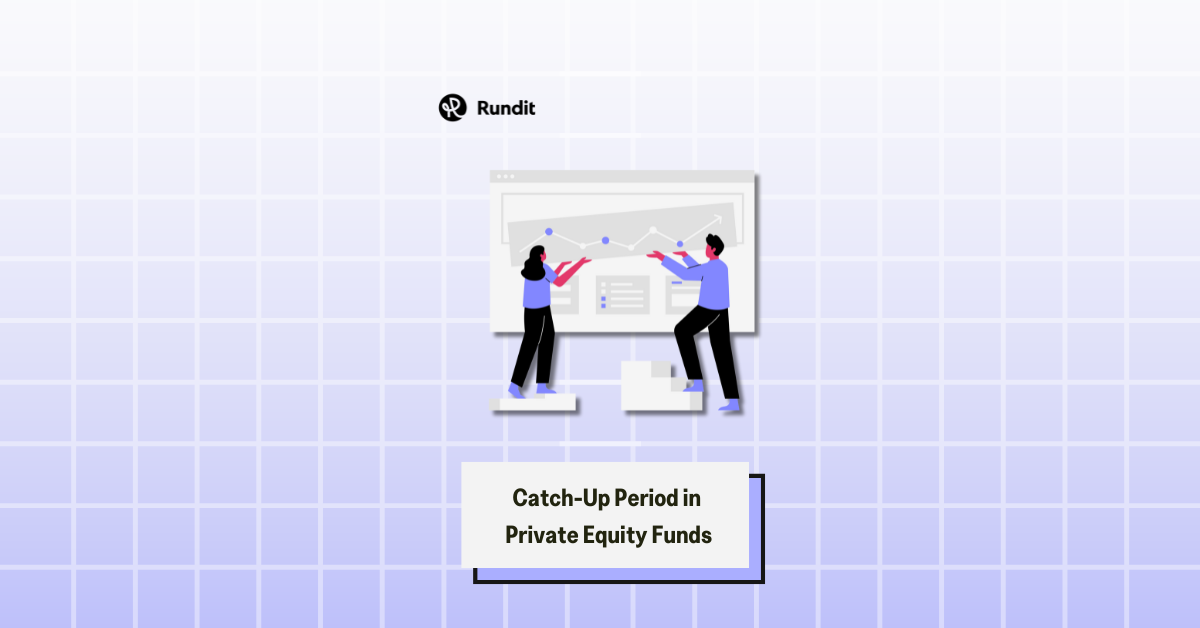
Private equity (PE) funds often include intricate compensation structures to align the interests of both limited partners (LPs) and general partners (GPs). One key aspect of this structure is the “catch-up period,” which dictates how profits are distributed between the LPs and GPs after the initial returns. Understanding the mechanics of the catch-up period, especially in the context of preferred returns, is essential for investors and fund managers alike.
In this blog, we’ll break down how the catch-up period works, its significance, and how it fits within the broader compensation framework of private equity funds.
In private equity, the typical compensation structure includes:
1. Management Fees: A fixed percentage of the fund’s assets, typically around 1.5% to 2%, which the GPs charge annually to cover operational expenses.
2. Carried Interest: The share of profits GPs receive after the LPs have received their initial investment back, usually around 20%. However, this profit-sharing is subject to certain hurdles, including a preferred return (often referred to as the “hurdle rate”) and the catch-up period.
A preferred return, or hurdle rate, is the minimum return that LPs must receive before the GPs are entitled to any performance-based compensation (carried interest). This ensures that LPs earn a certain level of return before the GPs start sharing in the profits. Typically, this preferred return ranges from 6% to 8% annually .
For example, if a private equity fund has a preferred return of 8%, the LPs must receive an 8% return on their invested capital before the GPs can claim their carried interest.
Once the preferred return threshold is met, the catch-up period begins. This is the phase where GPs are “caught up” to ensure they receive their full share of the carried interest.
Let’s break this down further with an example.
Imagine a private equity fund with the following structure:
– Preferred return: 8%
– Carried interest: 20% (GP) / 80% (LP)
– Total fund size: $100 million
1. Preferred return phase: LPs must first receive an 8% return on their $100 million investment. This means the LPs need to receive $8 million before any carried interest is paid to the GPs.
2. Catch-up phase: After the LPs receive the $8 million preferred return, the GPs will typically receive the next set of profits, often 100%, until the profit distribution is in line with the 80/20 agreement .
3. Sharing phase: Once the GPs have received their catch-up, any further profits are split according to the predetermined 80% (LP) / 20% (GP) structure.
Let’s assume that after the preferred return, the fund generates an additional $10 million in profits. In the catch-up phase, GPs will receive 100% of that $10 million (or enough to ensure their total share is 20% of the overall profits). Once the catch-up is complete, any remaining profits will then be distributed according to the usual 80/20 split between LPs and GPs.
The catch-up period is crucial because it incentivizes GPs to achieve high returns for the fund. By structuring the compensation this way, GPs only begin to receive their performance-based compensation (carried interest) after they’ve delivered solid returns to their investors. It ensures that both the LPs and GPs are aligned in their goals: maximizing the fund’s returns .
The standard catch-up structure described above can vary depending on the agreement between the LPs and GPs. Here are a few common variations:
1. 100% Catch-Up: The GP receives 100% of the profits during the catch-up phase until they are entitled to the full carried interest (as described in the example).
2. Partial Catch-Up: In some funds, GPs may only receive a portion of the profits (e.g., 50%) during the catch-up phase, rather than the full 100%. This results in a slower catch-up process for GPs .
3. Tiered Carried Interest: Some funds may have multiple hurdle rates and catch-up periods. For instance, GPs might receive 10% of the carried interest after an 8% return and 20% after a higher return threshold is met.
The catch-up period is a fundamental component of private equity fund compensation, designed to balance the interests of both investors and fund managers. By ensuring that LPs receive a preferred return before the GPs begin to share in the profits, the structure aligns the incentives of both parties, ultimately aiming to maximize returns for the entire fund. Understanding this mechanism is essential for anyone involved in private equity, from investors evaluating fund terms to managers structuring compensation agreements.
Rundit makes private equity fund management more efficient by automating critical processes, allowing you to focus on maximizing returns. Our platform provides real-time tracking of key metrics like hurdle rates, preferred returns, and distributions, so you can effortlessly monitor fund performance. With Rundit, you’ll have the tools to optimize reporting, enhance transparency, and keep investors informed—all while simplifying complex workflows.
Whether you’re managing capital calls, tracking carried interest, or navigating the catch-up period, Rundit offers the insights and automation you need to stay ahead. Ready to simplify your operations? – schedule a call with us!
1. Investopedia. (n.d.). [Private Equity]
2. Pitchbook. (2023). [Catch-Up Period Definition and Explanation].
3. CFA Institute. (2021). [Carried Interest in Private Equity].
4. Preqin. (2023). [Private Equity Performance Metrics]
5. Toptal. (2022). [Private Equity Fund Economics: Key Metrics and Terms].
Subscribe to our newsletter
Sign up to receive our newsletter for exclusive updates, insights, and exciting news delivered straight to your inbox.